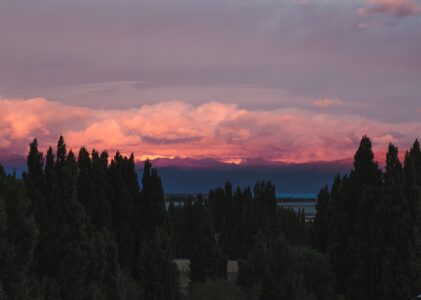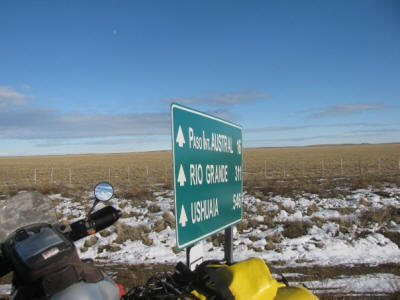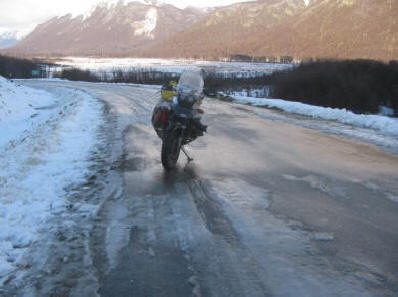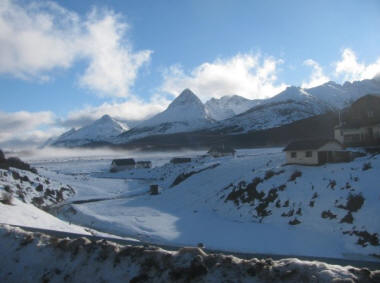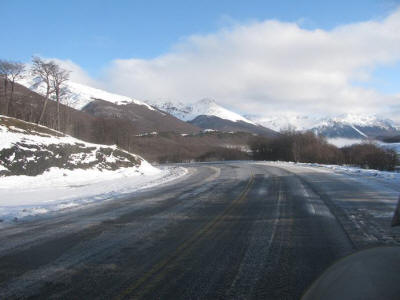El Calafate, Argentinie
11 May 2009
Veilig in El Calafate, die dorp naby die bekende Moreno Glasier. Het die slegste deel van Ruta 40 afgehandel vandag. Wat ‘n slegte stuk pad, maar pragtige Karoo-agtige scenery. Berge is oorals spier-wit gesneeu. Ons bly 3 aande hier, gaan dan verder suid.
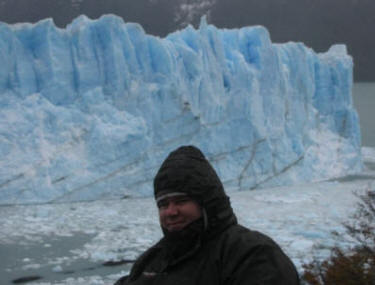
12 May 2009
Glasier is BEAUTIFUL! Can now understand some of the great sights Dad has seen in Antarctica.
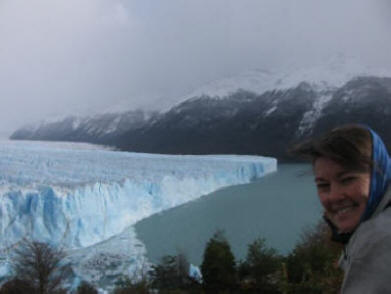
13 May 2009
We are off this morning to Rio Gallegos and might spend the night there. We have changed our route a bit due to the extent that the front shocks leak oil. I have managed to get Honda seals that will fit my bike in Rio Gallegos. The oil leak is so bad we get sprayed with oil as we ride, even on our helmet visors. I will replace the seal in Rio Gallegos, 250km down the road. The Moreno Glasier we’ve visited yesterday. It is like no other glacier we’ve seen. It is HUGE and very pretty. It tops our top ten most amazing things we’ve seen on this journey. The colours of the trees are amazing, just like we’ve seen in northern Alaska, orange, red and yellow.
Conditions are better sunshine all the way to Rio Gallegos……Johan now battling to loosen the top of forks to put new seals in!
Rio Granda Argentinie
15 Mei 2009
Een dag om te gaan tot die einde van die pad! Is tans in Rio Grande, het laas nag hier geslaap. Die blyplekke hier is vrek duur. Dis noggals ‘n groot dorp/stad, so in die middel van nerens. Stel jou voor ‘n dorp so groot soos die Paarl daar iewers tussen Copperton en Prieska. Dis soos die Rio Grande en Rio Gallegos lyk. Het die nuwe vurk seels by Rio Gallegois gekry by ‘n groot bike winkel. So die BMW is nou ‘n baster-bike, het Honda parte in. Meskien laat dit hom beter loop? Het gereedskap geleen by ‘n oomie wat wasmasjiene herstel. Ek ry mos nie met gereedskap saam nie, net ‘n waterpomp tang (kleintjie) en ‘n boesman-kitaar (shifting spanner), wat nie so lekker werk in klein gatjies nie. Nou kan ons weer sien hoe die wereld lyk, kry nie meer die olie spatsels op ons helm se visors nie, so 100%.
Het gester twee ander bikers op die pad gesien, ‘n Africa Twin en ‘n ou op ‘n Suzuki 250, so ons is nie die enigste mense wat die koue aandurf nie. Ja, dis koelerig, maar warmer as toe ons by El Calefate was. Daar le wel plek plek sneeu langs die pad en in die veld. Die area lyk nogals soos Sutherland in die winter. Daar is baie Magellan Ganse (‘n pragtige gans), Rheas (klein volstruisie) en Guanocos (bok met ‘n lang nek amper soos ‘n Llama). Ons sal laat weet waneer ons die mees suidelike stad in die wereld bereik het.
15 May 2009
Thanks to the Lord, we’ve done it – Prudhoe Bay to Ushuaia! Cold conditions but no rain. We will stay maybe 3 or 4 days, the forecast rains for the next few days – will wait it out.
Ushuaia, Argentina
15 May 2009
Today, the 15th of May, we made it to Ushuaia! 100,000km from Aghulas to Ushuaia! From the Southernmost point in Africa to the Southernmost city in South America (and the world) via Africa, South West Asia, Southern Europe, North and South America. Not too bad. It is a feeling I can’t describe, more than just another dream that came true! God is good. It was a sacrifice to leave behind our country, family, friends and careers but is worth every bit of that sacrifice. Thank you for your prayers to the Lord and regular email support. You are special to us.
So wat nou? Ons sal so paar dae hier bly en die weer dophou. Die laaste 100km voor Ushuaia het plek plek ys op gehad, veral die bergpass net voor die stad. Ons sal wag vir ‘n mooi sonskyndag voor ons ry, smaak nie die geglyery nie. Intussen gaan ons kyk om so paar toeriste dingetjies te doen, dis nou te se as dit nie te duur is nie. Dinge smaak my kos maar duur hier in die onderpunt van die wereld. Sukkel selfs om ‘n warm slaapplek vir onder $40 te vind. Argentinie is alles behalwe goedkoop. Die wereld is pragtig hier onder, wit onder die sneeu ook nog. Ek het heelwat fotos op Facebook gelaai so julle kan dit maar gaan uitcheck.
Die GS loop perfek, na ek die nuwe furk seels ingesit het lek hy geen olie meer nie. Oor die 165,000km op die klok and counting. . . . . . . . As ek so terug dink waardeer die bike nou al is, is dit darem ‘n taai stuk yster, nie perfek nie, maar taai.
Leaving Ushuaia
17 May 2009
We have decided to go back north today, as the weather forecast is snow for the next 4 days. We had an interesting experience yesterday, wanted to ride to the end of the road and take a picture at the sign that states it is the end of the road, it is on the far end of the national park here. After we paid our entrance fee to the park, we got as far as 200m down the road, which was actually an ice rink. It was a challenge turning around without dropping the bike. Charmaine had to walk back on the side of the road in the snow, as the road surface was too slippery! So we don’t have the photo we wanted but had fun building our first real snowman. The most difficult part of the road is over this mountain pass here. About 10km is in the shadow, so the snow/ice does not melt. We made it safely to here so will be fine on our way out again. God willing we’ll be in the Rio Grande tonight. We will keep going north on Ruta 3 till we find a nice place to relax and rest and do all the important emails that are now piling up.
This might only be in Sarmiento. Sarmiento is the ‘Afrikaner Boere’ town. Our forefathers (Boere) has built it and the surrounding farmlands 100 years ago, so we hope to speak some Afrikaans with the old folks and meet some nice people. Thanks for the nice comments you put on our Facebook photos. I need to do another movie too, see, I’m getting behind with my ‘work’. Don’t worry, be happy.
Argentina
18 May 2009
Another milestone was reached when we got onto the famous Ruta 40. The dreaded corrugated, potholed and rutted gravel road, beaten with high winds, runs inland north to south in Argentina. Because the road would be bad, we estimated that it would take us about three days to reach El Calafate – yeah right! We were pleasantly surprised to find the road in a better condition than the East African Highway and thankful to the Lord for keeping the infamous strong winds away. Once again the scenery blew us away – we thought we were back in the Karoo, beautiful flat dry yellow fields with thousands of sheep as far as the eye could see. The sky was mostly blue again and even though we had the warmth of the sunbeam on us, it was not enough to take the chill out of the air, the temperature remained below 8 degrees Celsius. We refuelled at Bajo Caracoles as we were told that there would be no fuel until Tres Lagos some 409 km south. Thankfully this is no problem for the GS, so we did not have to carry extra fuel in bottles. The road we would have taken if we were not stopped by the heavy snow would have joined onto Ruta 40 here at Bajo Caracoles. We looked at the mountains in the direction of Chile, and the road we would have come on from Cochrane and realised that we would not have been able to go that way, everything was white, literally snow white. We were doing good time and continued south all the way to Tres Lagos where the road became tar again. We managed to get into El Calafate as the sun was setting. Thank you, Jesus, for giving Johan the wisdom to read the road and handle the GS so that we had a safe journey. The freezing cold weather and Ruta 40 took their toll on the poor GS as both her front fork seal went and after some investigation, we managed to find a Honda dealer that sells that same size seal in Rio Gallegos.
One of the absolute highlights of our total journey has been the Moreno Glacier. It should be an absolute must on everybody’s wish-list of things to see in their life. It is another wonder of the world that makes us realise that we serve an awesome God and we get to see how great His creation is. The Perito Moreno Glacier is one of only three Patagonian glaciers that are not retreating. It is a 250 km2 (97 sq mi) ice formation, and 30 km (19 mi) in length. The front edge of the Perito Moreno Glacier is 5 kilometres (3 mi) wide, with an average height of 60 m (200 ft) above the surface of the water, with a total ice depth of 170 metres (558 ft). It advances at a speed of up to 2 metres (6.6 ft) per day or around 700 metres (2,300 ft) per year. It is mind-boggling to hear the snapping sound as the ice cracks from the pressure of the huge mass moving forward, then seeing the chunks fall off into the water below. It is well worth standing in the freezing wind, waiting and watching for the pieces to fall. Thank you, thank you, Jesus!
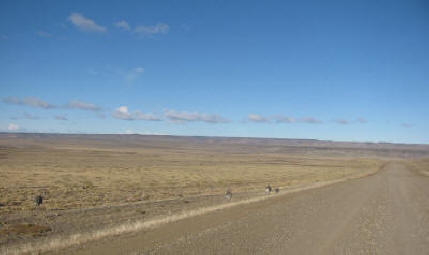
22 May 2009
In Comodoro Rivadavia, temp warmer between 4 and 9 deg.
Chubut, Argentinie
22 Mei 2009
Het vandag die dag in Comodoro Rivadavia spandeer. Het een Afrikaans sprekende persoon opgespoor deur die Toeriste informasie senter, ‘n Maartin Blackie. Ons gaan more by hom koffie drink op pad uit na Sarmiento. Hy het my op die foon vertel dat baie mense in Sarmiento praat Afrikaans, so dis goeie nuus en iets om na uit te sien.
Southern Patagonia
27 May 2009
From El Calafate to Rio Gallegos was a nice, easy ride. At one point the altitude rose above 700m and the temperature dropped as we gained height. As we were cruising along and steadily climbing up a mountain road and admiring the fantastic views it gave us, I felt the back end of the bike slip slightly in a corner. I noticed a darker section in the road and assumed it was oil or diesel spilt by a truck, slowed down a bit and tried to stay off the dark section. A few corners down the road I felt it again and then as we turned in a direction of the sun I saw the road surface shine brightly as if it was wet. I moved off onto the gravel shoulder of the road and stopped to check out the shiny reflection on the road surface, it was nice and really slippery! So we got to see for the first time what I think is known by many as black ice. It is a thin layer of frozen water on the surface of the road. Dangerous for cars, let alone a motorcycle! From here on we drove next to the road for a few kilometres and the road surface turned white with ice. Needless to say, the temperature was close to freezing, but by now we were sort of getting used to it. We made it safely to Rio Gallegos and picked up two new fork seals for the GS at the local bike dealer.
This was an impressive bike shop for such a remote town. There were lots of new bikes on the showroom floor, from small Moto-X bikes to some big Yamaha FJR1300s. It was an easy task to replace the seals, once you have the correct tools. I don’t carry any tools other than the basic BMW kit that comes with my bike, so I had to borrow a socket from a toppie (elderly man) in a washing machine workshop. It worked and luckily there was no damage to the chrome on the shafts. Rio Gallegos is quite a big town and has big shops and lots of crazy drivers too. I still don’t understand the traffic rules in these towns. At the intersections (big and small) there are no signs of who must stop or not, so you have to stop at almost every intersection, and if you do the cars behind you ride about 2 inches from your back-end. They clearly have no respect for motorcyclists here in Patagonia. You stop at a red traffic light in the middle of the lane, like you would do back home and in most countries, and the car behind you will squeeze itself next to you and the car in the next lane. They seem to have the same driving style I saw in Pakistan, where driving lanes doesn’t mean anything.
The next day we were on the road again, this time on Ruta 3 south, the end of the road was another 600km further south. We crossed the Strait of Magellan on a ferry to get onto the Tierra del Fuego Island. We spent a night at the Rio Grande and left again the next day for the last section of the road. Not far from the Rio Grande the scenery slowly changed from flat Karoo-like plains to trees. It eventually changed to a complete forest similar to what we saw in Alaska. The mountains were white with snow and we saw amazing scenes that we would not have seen if we were to come down here in summer. 80km or so before Ushuaia the road goes over a small mountain range. Ahead of us, we saw that the road goes above the snowline, so I let some air out of the GS tyres for better grip in snowy conditions. As we came to the top of the mountain pass we saw that the other side (Southern side) had lots of snow till down in the valley. Because of the extreme angle of the sundown here, 20 or more kilometres of the road was lying in the shadow of the mountain and does not get any sun all winter. This meant not only snow on the road but ice. Luckily there were two tracks that we’re through to the road surface, all I had to do was to make sure I stayed in these tracks. All my concentration was on the road in front of us and stopping to admire the scenery was out of the question, as everything next to the driving lane of the road was snow and ice. Once we got out of the shadow and into the sun the road surface was clear which allowed me to look around and appreciate the beauty of the winter scenery. Everything was white and we saw people skiing on the nearby slopes. They must have thought that we were crazy coming down here this time of year on a motorcycle.
Yes, we are crazy, but if we weren’t we would have stayed home and watched other people’s adventures on Discover Channel or YouTube. . . . . . . . . . . . . . . . . BORING!
Ushuaia seems to be dead this time of year, with nothing going on. We struggled to find a hostel that was not closed for renovations nor had space for us. After more than an hour’s searching, we found one, but they sure aren’t cheap. This would mean that we will not stay as long as we would have liked. The weather forecast did also not look favourable for us. Ushuaia is not the end of the road, and the next day we left to ride the 30 or so kilometres further until the end of the road that lies in the Tierra del Fuego National Park. We arrived at the entry gate of the park, paid our entrance money and drove in. 200m down the road I realised with horror we are riding on solid ice. Like I said everything around was white with snow, but the roads were graded in town and up to the gate we were fine. When I realised we were on the ice I wanted to stop and turn around. This was a difficult task and as I touched the brake the wheel locks up, so I released the brake. The same with the rear wheel when I wanted to slow down on the engine brake. Clutch in and I applied the most gentle rear-wheel braking I’ve ever had to. We came to a halt and I struggled to get enough grip with my feet so that Charmaine could get off the bike and help me turn the GS around. We made it without falling over, the bike struggled to get going, as it was now uphill and as soon as I released the clutch the back wheel just spun, no grip at all! I started to get angry at the ladies who took our money at the entrance gate and did not even warn us about the ice on the road in the park. This was crazy! Somehow the Michelin tyre found grip and I got the big GS to start moving forward. Again, it was the most gentle clutch release I have ever had to do on a bike, but it paid off and I made it back to the gate, Charmaine had to walk back in the snow next to the road, as the road surface was too slippery to walk on!

The friendly young ladies at the gate gladly gave me back our park entrance fee and were very surprised that I am not able to ride on the ice? They clearly have got no idea of Motorcycles, do they? We spent some time at the gate playing with the snow and building a small Frosty. This was the first time on the journey that we were amongst snow that was not actually falling from the sky, so we could enjoy the snow for a change in some sunshine. We drove back to Ushuaia somewhat disappointed that we could not reach the real end of the road and take the photo we were looking forward to taking at the sign down there. Back at our hostel, we saw that the weather forecast was not looking good in three days’ time, with snow and more snow to come. I don’t want to be snowed in down here for so long, so decided to pack up and head back north the next day.
On our way out we stopped at one of the skiing resorts that also do Sled Dog trips. This was something I always wanted to do, going on a dog sledge ride. It was not cheap, but it was lots of fun and worth every cent we’ve spent on it. We were amazed at the speed these 6 x Husky’s were able to pull us at. They are amazing animals and it was nice to see how well looked after these dogs were. The guide who took us on the ride could speak some English and told us that they use these dogs to take part in various dog sledge races down there. After the dog ride, we were back on our two-wheeler on the icy road and over the mountain pass. We noticed that there was lots more snow than when we drove on this road three days earlier. The temperatures were below freezing (-3degC) and the lakes were now frozen solid that was still water 3 days earlier. I would have loved to spend more time down in Ushuaia, but it was time to get out of there. Down in Patagonia, we don’t get to ride long distances in a day, the day is just too short and too cold. 400km is a long day for us in these conditions, and we ended up arriving at both Rio Grande and Rio Gallegos after sunset. Our rain suits are by now completely tossed and is held together with lots of duck tape. We wear them every day for protection again the cold, rather than the rain. If we must get any rain now, even a light drizzle, we will be wet. We haven’t seen two digit figures on our temp gauge for weeks now, and we are longing to get back to the nice tropical weather we enjoyed in Central America.
We drove north on Ruta 3, Argentina’s main road that will take us all the way to Buenos Aires. The ride from Rio Gallegos to Comodoro Rivadavia (850km) took us two days. We slept in the only noticeable town between the two towns. There is not much to see down here and the scenery is like southern Namibia. It is the perfect road to kill some distance in a short time, but there is just one problem, the wind is howling as I’ve rarely experienced it. The morning of the second day we woke up with this howling wind. Thank God we were not in the tent, it would have been unpleasant to try and pack up in this icy cold wind. After breakfast, we set out and had the wind directly from our left side. I was driving at an incredible angle and fought the wind the entire day. Every time a truck passes from the opposite direction we were all over the road and fighting to keep it within our lane. To top it all we almost ran out of fuel too, as we got 100km less out of the tank than what we would have in normal conditions. We saw another biker going south on his KTM 990 and he also seemed to have a tough time keeping his machine in a straight line. We stopped a few times to take photos and could not standstill due to the wind. That evening when we drove into Comodoro we were relieved and tired.
Comodoro Rivadavia was our entrance into the Chubut province of Argentina. This province has some local interest for me. Most of the province was settled and developed by Welsh migrants in the late 19th century, but the south around Comodoro Rivadavia and Sarmiento had been settled by Afrikaners that migrated here in the early 20th century (1902-1910). It was one of my personal goals to visit these areas that were settled and developed by the Boers (Afrikaners) and if possible find some descendants that still speak Afrikaans, more about this in the next story (in Afrikaans of course).
Those of you with GS’s (and LT) will be delighted to hear that my rear wheel bearing is still going 100% after the modification I’ve done in the USA. We’ve done more than double the distance on this bearing than what we’ve done with any of the previous bearings. We’ve ridden on every thinkable road condition. We changed the dif oil in Peru, and it was mixed with water due to the deep river crossing we’ve done. This is normally not good for bearings, but like I said it is still going very strong with close to 40,000km of rough riding. Others failed within less than 20,000km. Anyone interested to learn more about this mod, send me a mail and I’ll gladly share my knowledge with you to make your GS’s diff (or LT) more reliable.
Buenos Aires Province, Argentina
31 May 2009
We have officially left the area known as Patagonia today when we crossed the mighty Rio Negro (Black River). We’re in a town called Carmen de Patagones, now only 1000km from Buenos Aires. We’ll do the 1000km in two days. The weather is much better up here, the temperature was a lovely 15 or up most of the day. The scenery and road are still extremely flat and uninteresting. We saw lots of whales this morning.
Buenos Aires
9 June 2009
We are getting ready to leave this morning. We had a fantastic time here in Buenos Aires with the lovely CMA people. We have not seen much of the city itself, but that was never really our intention why we came here. We wanted to meet the CMA guys.
Here are our route plans: From BA we will go to Rosario, then on to Cordoba on Ruta 9. From Cordoba north to Salta and the surrounding towns, where we will stay a couple of nights and explore the area. Then we will come south to San Miguel de Tucuman, where we will meet up with the CMA chapter there on the 20th or so. It seems that Charley might ride up to Tucuman to meet us there. Not confirmed yet. From Tucuman, we will make our way south to San Juan and Mendoza. Somewhere between the 5th and 10th of July we will go back into Chile and straight to Valparaiso to get the bike to send off to Australia. Then we will start thinking and planning our next ‘adventure’, New Zeeland. That is as far as we have planned.
Like I said on the phone, the bike is running ok, not perfect, but ok. It needs to be looked at, but that is something I prefer to do in an English speaking country where I can at least understand the mechanic. It surges, or splatters under hard acceleration, like when we want to overtake a vehicle. I think it might be either the injectors or coil, or even something with the electronic timing, that might have to go to a BMW dealer, but I don’t have much faith in them, as we have been disappointed too many times. It will take time and more $$$$ to get it fixed, we don’t have so much of that at this stage. The RID panel on the bike’s dash has blown out too. It cant be repaired as a section of the circuit board is destroyed. It got wet too many times I think. The RID has the fuel and temp gauge, gear selector and time. I don’t need those and will replace them once I can get my hand on a secondhand one. In this part of the world, there are very few 1150s, so secondhand parts are expensive and hard to come by. (not so in South Africa). Nothing to worry about, as long as I don’t accelerate hard, the bike runs 100%. Yes, amazingly we saw lots of new BMWs (1200’s) here in Buenos Aires, and with a price tag of $25,000 and more for a 1200, there is no shortage of money here in Buenos Aires.
9 June 2009
We are spending the night in Bell Ville, on Ruta 9.
Noord Agentinie
13 Junie 2009
Ons is nou amptelik in ‘n lekker warm area vir ‘n slag, heel in die noorde van die land. Die area lyk soos die Lae Veld daar by die Oos en Noord Transvaal, behalwe dat dit baie meer plat hier is. Hier is nou nie eens ‘n heuweltjie in sig nie. Van BA af het ons met Ruta 9 gery tot by Santiago Del Estereo. Ons het laas nag in ‘n nasionale park (Copo) geslaap in die hoop om van die plaaslike diere te sien, maar al wat ons gesien het was stof. Nou is ons by ‘n kleinerige dorpie op ruta 16 op pad na die rigting van Salta provinsie. Weet nie waar ons vanaand gaan oornag nie. Die deel van die land blyk heelwat vriendeliker as die suide.
Chubut na Buenos Aires
16 Junie 2009
Die Chubut provinsie le in die middel van Patagonie, ‘n harde wereld wat ons eie Karoo mak laat lyk. Dis hierheen waarheen 400 of so Boere getrek het na die 2de Vreiheids Oorlog (of Anglo Boere oorlog). Die meerderheid van hul nasate woon vandag in Comodoro Rividavia, Sarmiento en omligende plase..Ek was opgewonde om die area te besoek en het gehoop om van die mense te ontmoet. Ek het ook gehoor dat van hulle steeds Afrikaans praat. Na die lang vervelige, winderige pad vanaf Rio Gallegos in die suide kom ons eindelik by Comodoro aan. Na vele gesoek kry ons darem ‘n hotel wat binne ons finansiele bereik is. Pategonie is verbasend duur, veral verblyf. Dis winter, daar is geen toeriste nie, en jy sukkel om ‘n kamer onder $50 (R300) te kry. Die volgende dag is ons na die toeriste informasie kantoor om uit te vind waar die Boere mense is. Hulle weet nie waarvan ons praat nie, of so laat hulle ons verstaan. Die een dame wat so half engels kan praat bel gou iemand anders, wat vir haar die nommer gee van iemand wat deel is van ‘n Suid Afrikaanse klub of so iets. Charmaine bel die man, wat in Spaans antwoord en praat. Sy vra of hy dalk Engels verstaan of praat, maar soos al sy mede landgenote is die antwoord nee, geen engels. Dis toe dat hy oorskakel na Afrikaans en vra: “maar wat van Afrikaans?” Die volgende dag gaan le ons besoek af by Martin Blackie. As ek die storie reg het, het sy Ouma en Oupa hierheen getrek vanaf Suid Afrika Hy is natuurlik hier gebore en het in ‘n Afrikaans sprekende huis grootgeword. Hy het getrou met ‘n vrou wat nie Afrikaans sprekend is nie, so met die gevolg sy kinders en kleinkinders praat nie die taal nie. Van Martin af is ons reguit na die dorp Sarmiento, waar ons gehoop het om meer Afrikaans sprekende mense te ontmoet. Die dorp self was maar droewig, en meeste van die huise val half uit mekaar uit. vir 4 dae soek ons iemand wat bietjie Afrikaans verstaan, maar tevergeefs. Daar is nie eens ‘n winkel of ‘n plaas met ‘n half Afrikaanse naam nie. Ek wonder waar die 500 of so Afrikaans sprekende mense wat Martin van praat is.
Ons het een dag uitgery na die indrukwekkende versteende woud met 100de versteende boom stompe. Dit was ‘n besonderse gesig en het wel ons Sarmiento besoek die moeite werd gemaak. Van Sarmiento af is ons weer terug deur die ys koue vlaktes na Comodoro en toe noord met die vervelige Ruta 3. Puerto Madryn was ons volgende merkwaardige stop. Dit was die netjieste dorp wat ons sover besoek het in die land. Die huise is netjies en die kuslyn is eintlik pragtig. Puerto Madryn is duidelik ‘n vakansie dorp. Die dorp is bekend vir sy oorvloed in walvisse en see leeus. Ons het die geleentheid gehad om beide te sien en te hoor. Vanaf Puerto Madryn is ons weer verder noord op die vervelige Ruta 3. Die Ruta 3 is regtig ‘n droewige stuk pad en strek vir 3000km suid vanaf Buenos Aires tot by Usuaia en daar is bitter min om na te kyk langs die pad. Die wereld is plat soortgelyk aan die pad tussen Springbok en Vryburg daar deur die Kalahari, maar dubbeld die afstand.
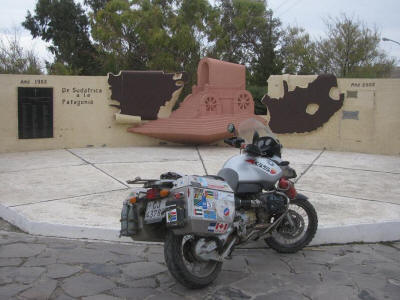
Agentinie is die land waarin ons die meeste gesukkel het om te komunikeer. Die beste gesprek wat ons in die land gehad het was met Martin, en dit dan ook nog in Afrikaans. Engels bring jou omtrent nerens nie en ons kry die indruk dat mense anti-engels is en onbereid is om geduldig met jou te wees as jy engels praat. Die verskynsel is egter nie die geval in die noorde nie, maar defnetief suid van Buenos Aires. Ek wonder of dit iets te doen het met die Falkland ylande en die oorlog wat hulle teen Britanje verloor het. Meskien is hulle nog suur daaroor? Buenos Aires is ‘n ander wereld en duidelik finansieel meer welaf as Patagonie. Die stad is baie groot en eers het ek nie baie uitgesien om daar in te ry nie. Dinge werk toe so uit dat ons die stad binne ry gedurende spitsverkeer, maar verbasend vloei die verkeer heel goed en sonder enige drama stop ons by Charley se kerk in Olivos, ‘n voorstad van Buenos Aires. Charley is die leier van CMA in Argentinie. Hy lyk na ‘n rowwe ou met lang deurmekaar hare en ry ook nog ‘n Harley Davidson, maar het eintlik ‘n hart van goud. Ons het Charley ontmoet in die VSA tydens die CMA Internationale konferensie. Die eerste aand slaap ons sommer daar in die kerkgebou oor, en die volgende dag toe boek Charley ons in ‘n hotel naby die kerk. Die CMA lede hier in Buenos Aires het ons omtrent op hul hande gedra en het ons behoorlik bederf met hule geselskap en Argentynse kos. Meeste van die tyd was daar iemand wat namens ons kon vertaal so ons kon darem ‘n paar goeie gespreke voer met ons broers in Christus in die deel van die wereld. Die hoofdoel hoekom ons Buenos Aires besoek het was om vir Charley en die mede CMA lede te ontmoet, so ons het nie regtig veel van die stad te siene gekry nie. Dit was ook lekker om vir ‘n slag dinge rustig te vat en net te rus.
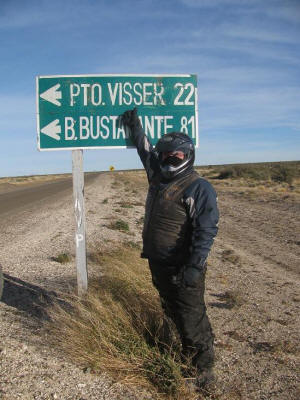
Jujuy, Argentinia
17 June 2009
We are safely in Jujuy. We are finally in what seems to be the nice part of Argentina. Friendly people and beautiful scenery. I’ve uploaded another YouTube movie, that covers Moreno Glacier and Ushuaia. We plan to spend the next 5 or 6 days between here and Iruya.
Buenos Aires and North
30 June 2009
The Chubut Province in the northern part of Patagonia is very similar to the Karoo in South Africa. Commodore Rividavia, Sarmiento and the neighbouring farming area is where Afrikaners can still be found today; they arrived in the early 1900s after the Boer War. We were very blessed in finding one Afrikaner, Martin Blackie! He had his own little bakery that specialised in the HUGE loaves of bread that are used to make sandwiches. He also made the best ‘medialunas’ (croissants) we have had in Argentina! It was interesting chatting to Martin as like most other Argentineans, he could not speak English but thankfully he spoke good Afrikaans. He said he regularly gets contacted by South Africans who are interested in moving to Argentina but knows that the Spanish language is a huge hurdle and keeps many away! Heading north we stopped at Puerto Madryn, this was by far the most modern and upmarket little town we had seen. It is a favourite place for the locals to come on holiday and it is a huge tourist destination as the bay is frequented by Southern Right Whales and Sea Lions right through the year. During the summer months, the Jackass Penguins nest along the coast and the Sea Lion colony expands by the thousands as they come to the beaches below the cliff to have pups. This is when it gets really interesting as the Orca (killer) Whales also come into the bay to feed on the sea lion pups. We were blessed to see some Sea Lions lazing in the sun on the beaches below the cliffs and we also saw the Southern Right Whales really close to the shore. They were so shallow that I’m sure they were scratching the barnacles off their bellies on the sea sand while baking their backs in the sun. We could hear them communicating with each other; the sound gave a feeling of calm and awe! My, what an awesome God we have, to create such gentle giants!
The road from Southern Patagonia to the north to Buenos Aires is really flat and after 3000km quite monotonous. For a change it was nice to have big buildings and spaghetti flyovers to change the scenery. Buenos Aires is really big and despite the many apartment buildings and houses all built onto each other; it is neat and relatively green. Many of the streets are tree-lined and there are many plazas with lovely gardens. We did not have a city map but thankfully Johan had studied the route on Google Earth and had put waypoints into the GPS! We got into town just at what seemed to be peak traffic time, but thankfully it flowed. Without any problems, we found our way to Charlie’s church in Olivos. Hallelujah! It was great seeing Charlie again and meeting some more CMA family – Gaby, Jale, Veronica, Rebecca, Andreas, Horacio, Gustavo, to mention but a few, there were so many more wonderful brothers and sisters in Christ. Claudia (ex USA) but now a local of 20 years gladly translated for us. We had a super time with them; we had ASADO (BBQ/braai) on three occasions in one week! These Argentineans love their meat. The local CMA chapter had a gathering at their club which is at the back of the church building (a really really great setup). Then the one evening we all went to visit another CMA chapter more than 50 km away in temperatures below 10’C! These guys are awesome, no distance is too far and the weather is never too cold – Charlie on his Harley Davidson, 5 brothers on their 250cc and smaller bikes, Rebecca on her 125cc scoot and the two of us on the GS! The rest of the gang were all piled into Gustavo’s taxi! We arrived at Alicia’s house and were greeted by some more loving CMA’ers. Wow, we sure are in an awesome ministry, to have so many brothers and sisters all over the world, thank you, Jesus! We had yummy empanada’s (similar to Cornish pies) and then the Asado came in from outside! The evening was finished off by everyone signing their name on a beautiful hand-drawn picture of the CMA biker hugging a brother… The one afternoon Gustavo picked us up in his taxi and took us on a conducted tour of the City Centro, the new waterfront development of Puerto Madero and Caminito, the most famous street in barrio La Boca which is filled with colourful corrugated buildings, small crafts fair and tango dancers performing for small change. We had a special homemade lunch with friends at Veronica’s house for our 5th wedding anniversary! We had the best Ravioli outside of Italy at Charlie’s favourite lunchtime restaurant in Olivos. We also got to share some of our photos by giving a slide show at the church and then it was with a sad heart that we had to say goodbye to our new friends and family. We were truly spoilt by CMA Argentina, thank you, Charlie, thank you, brothers and sisters, we love you! (see our latest YouTube movie about our visit to BA and CMA Argentina).
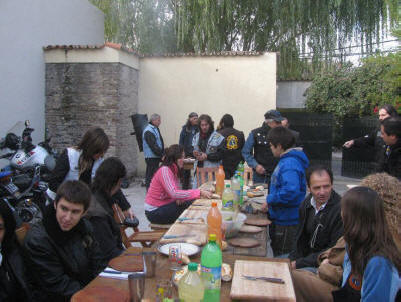
We were on the road again and heading more north, slowly making our way towards the warmer area of the Jujuy Province. The land was still flat but the vegetation become thicker with thorny trees and shrubs like Namibia, some areas had grassy ‘pans’ and it reminded me so much of Etosha, the only thing missing was the wild game! We did not see any animals other than dogs, pigs, goats, cattle and sheep. We have seen many raptures, doves, pigeons, several species of parrot and LBJ’s that fly in fairly large flocks. We went to the Parque National Copo in hopes to see some wild animals but all we saw was dust from the thick powder sand that we had to ride through, especially when the one section got the better of us. It was one of those moments when before you know it, we found ourselves and the GS on our sides waiting patiently for the dust to settle before we all got up-right and on the move again! We went on a ride through the park and it was rather disappointing to see domestic animals roaming around! We camped the night and were pleasantly surprised that we did not freeze our butts off! We went through some pleasant little towns with wonderful friendly locals; the people in the north are far easier to communicate with than those in the south of the country. The northernmost town that we have visited in Argentina is Tres Cruces, a one-horse town with a little corridor that served a great meal of soup and meat with rice. We stay a night in Iruya – a rustic little village built on the slopes of a mountain in an amazing valley at 2800m. The village is 53km’s from the tar road and goes through the most spectacular scenery. The road zigzags up and over a mountain and along the valley floor, we had to cross the river a few times but thankfully it is not the rainy season so it was very shallow. An observation when we were riding out of the valley the following morning, was that there was a lot of ice on the edge of the river and small streams were frozen…, that’s right, it gets so cold at night that the water freezes but the sun is warm enough in the day to melt it!!
The villagers in this area are mostly of Indian descent and are much poorer than their Spanish countrymen in the south. We saw people travelling by their horses and donkeys along the road to the market and others riding in their really old beat-up bakkies (pick-ups)! The other popular means of transport is the bus service; it always amazes me to see the busses on these tight narrow dirt roads with the locals peering through the dust covers windows. The slopes of the mountains and hills are not only rocky but they are also covered with small thorny trees and cacti. Huge big cactus-like we saw in Arizona poke up into the beautiful blue sky and little cactus the size of a tennis ball cluster on the ground. Just outside Humahuaca, we found a futuristic place to pitch the tent for the night. We had tall and small cactus all around us but managed to find a clear enough spot, close to a goat farmer’s house. The farmer stopped to chat and he could not understand why we wanted to camp as it got ‘mucho frio’ but after explaining in our few Spanish words that the scenery was just too beautify to miss, he smiled and wished us good night. It did get really chilly in the early morning as the wind started to blow, so we stayed in the tent until the sun-beam took some of the chills out of the air and the wind died down again. After we finished packing, we went with the friendly farmer to look at his goats; he told up that he sells milk and cheese in the town.
The mountains in this area have steep sides in the most unnatural colours and forms. Some areas look like church organ pipes reaching from the valley floor right up into the most beautiful blue sky. Rock and ground colours range from black, brown, green, purple, red, pink, orange, yellow, white and so many shades in between. The most spectacular and diverse contrast in colours can be seen in the village of Purmamarca. The village in itself is futuristic to see, the houses are red clay brick and very earthy looking. Cobbled streets and the village square littered with homemade crafts from the local Indians. The backdrop to the village is the Cerro de Los Siete Colores (Hill of Seven Colours).
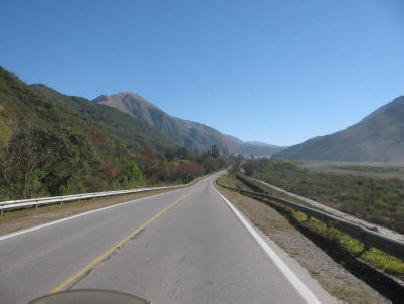
Back to Chile
2 July 2009
Ons het die laaste twee dae hier in Mendoza spandeer. Mendoza is eintlik ‘n baie lekker stad met pragtige boomryke strate en koffie winkels en resturante soos ons in Frankryk gesien het.
Dis nou aand hier, en ons beplan om more oor die berg te ry terug na Chile. Die pas is tans oop, en ons behoort ok te wees wat sneeu en ys betref. Ons sien op die nuus dat die Meksikaanse griep (Swine-flu) Buenos Aires beetgekry het, skole is toe en so aan. Hier in San Juan en Mendoza sien ons so paar mense wat met daai maskertjies loop. Ons hoop maar Santiago is nie so erg nie, wil tog nie nou ‘n siekte optel nie. Na amper twee maande en 10,000kms in die land, is dit tyd om in Valparaiso te kom en die bike op die boot te sit vir Australie. Ons sal egter die naweek in Santiago spandeer en seker eers sondag afry na Valparaiso. Die hostal waar ons die bike gaan skoonmaak en krat is nie so nice nie, so wil nie langer daar bly as wat ons moet nie.
Pumamarca, Argentina
14 July 2009
The last mail report was from Pumamarca, Argentina, where we stayed 3 lovely days, and explored the surrounding area, including the Grande Salinas. The Grande Salinas are a complex of huge salt flats, similar to the famous Uyuni salt flats in Bolivia, but not as big. The 80kms of road between Pumamarca and the salt flats were amazing and winds its way up the mountain from 2400m to 4200m in just 35km through some of the best scenery in Argentina. On top of the mountain, it drops down again to about 3500m, where the enormous salt flats are. We drove about 30kms on the salt, navigating our way with the GPS. It was a great experience and we took some nice and creative photos.
From Pumamarca we rode to Salta, one of the main cities in the north of the country. There we stayed another 3 nights and explored the city centre a little bit. After seeing so many beautiful colonial cities in Mexico and Ecuador, we did not find Salta attractive, despite its reputation as Argentina’s best colonial city. Our infamous Lonely Planet travel Guide raved about Salta and its colonial centre, we’re still not sure what they were on about as the city looked like any other Argentinean city where people did not seem to take much pride in the colonial history as we experienced in other countries, especially Mexico. It was also time to change the oil on the GS, and the little shop I bought the oil from insisted that they will change the oil for me free of charge. Since the Hostel we stayed at did not have many facilities to drain oil, I agreed and let them do the oil change. When they were done, I rode the bike around the block and back to the hostel. The next day I decided to make sure that the teenager-mechanic tightened all the bolts properly, and discovered that not only all the bolts on the belly plate were loose, but two were also missing! Furiously I walked over to them asking about the two missing bolts. It turned out that he did not even bother to put the two bolts on, as there were 6 others to hold the plate on!? With my lack of Spanish it was no use to try and argue with this dude and just ask him to give my bolts back. Back at the bike, while tightening the belly plate bolts I saw some oil laying in the belly plate too. Yes, even the sump plug was not tightened properly! Good thing I checked. Mind you, I had similar experiences after the bike came back from a BMW dealer, so I guess the moto is just to check every time someone else put a spanner to your machine.
The road from Salta down to Cafayate was again, one of the most scenic roads we’ve been on in this country. The road goes through a narrow valley with amazing rock colours and formations. The town of Cafayate was very nice too. It is one of Argentina’s main wine-producing areas, and the winter-coloured vineyards gave the town a real touristy and relaxed feel. It reminded us of our own Franshoek or Riebeeck Kasteel. The road between here and Mendoza also went through some nice scenery, although we were riding mostly on the flat plains, we always had huge mountains on our right side to look at. Just north of San Juan we dropped in altitude as well as in temperature. We were back in the below 10 deg C range. I started to get a bit worried about the mountain pass over to Chile. I’ve read reports from other travellers getting stuck there in snowfall and others sliding on ice. It is mid-winter and the chance for snow and ice is very high. After more than 10,000kms in Argentina, we arrived in Mendoza, a big, but very impressive and lovely city. We rode around looking for an affordable hostel, but most were surprisingly expensive and out of our budget until a guy on a bicycle told us he know a place that will suit our budget, and led us to the perfect hotel with safe indoor parking for the GS.
Mendoza is the kind of place where you can stay for weeks. It has a very attractive centre with a few pedestrian roads lined with coffee shops and restaurants with outside seating, umbrellas, live musicians playing lovely local music for a few cents, shoe polishers etc. There are also a few lovely plazas (parks) and tree-lined streets that give the city centre a very relaxed atmosphere. We checked the weather forecast and road conditions on the mountain pass to Chile, and it seemed clear for the next day only, so we had no choice but to saddle up and get over the mountain while the sun was shining. A pity, we would have liked to have stayed longer in Mendoza.

